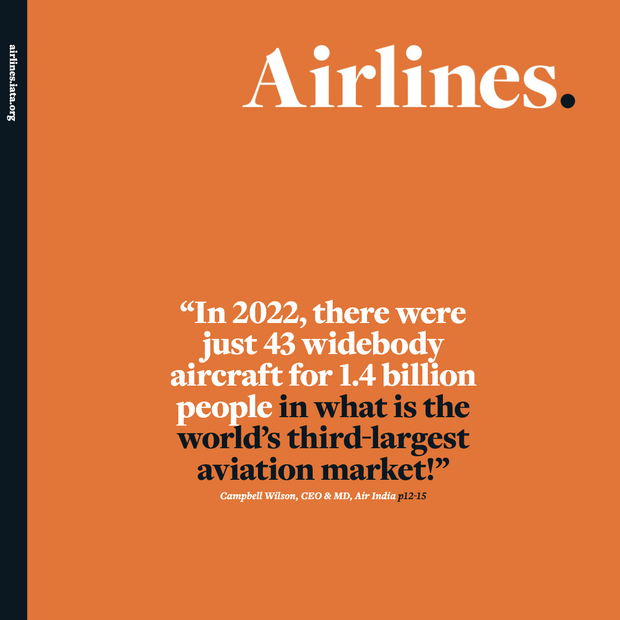
Translations: 国际航协发布净零碳排放增强政策和金融路线图 (pdf)
الاتحاد الدولي للنقل الجوي يصدر خرائط طريق محسنة للسياسات والتمويل لتحقيق صافي انبعاثات صفرية (pdf)
Miami – The International Air Transport Association (IATA) released updated Policy and Finance Net Zero Roadmaps, containing expanded and deepened analyses, bringing into focus four key conclusions:
- The air transport industry’s energy transition is feasible on the 2050 horizon.
- The amounts of investments needed to make that possible are comparable to those engaged in previous creations of new renewable energy markets.
- Success in the transition depends critically upon policymakers’ unity of purpose.
- The time left for joining forces in air transportation’s energy transition is shrinking by the minute. Every action delayed is an opportunity missed.
"The updated IATA Policy and Finance Net Zero Roadmaps make it clear that decarbonization by 2050 is possible. They also sound a warning bell that, to achieve this, all stakeholders, particularly policymakers, must collaborate more broadly and act with greater urgency. To be successful, we need clear policy and financial frameworks that will support air transportation’s needs in a way that is realistic and coherent with the massive changes that must take place simultaneously in all economic sectors,” said Willie Walsh, IATA’s Director General.
The Policy Roadmap emphasizes the importance of strategic policy sequencing and addresses the need for global collaboration, including beyond the aviation sector. The recommendations recognize that there is no one-size-fits-all solution, and policies must ensure that all countries can participate in the future global Sustainable Aviation Fuel (SAF) market.
Highlights include:
- Immediate Action is needed to unlock the Carbon Offsetting and Reduction Scheme for International Aviation (CORSIA) Eligible Emissions Units (EEUs) and prioritizing SAF in the product mix at refineries.
- Strategic Policy Sequencing combining technology-push and demand-pull measures will be critical. Moreover, governments must foster global, liquid, and transparent markets for cleaner aviation energy.
- Transformative Collaboration between governments, the aviation sector, and across all sectors to remove existing barriers and promote investment in new technologies, SAF, and infrastructure. This recognizes that air transport’s decarbonization is part of the broader global energy transition. The creation of a global SAF accounting framework is also essential to ensure transparency and prevent double counting of SAF’s environmental benefits. Addressing the current fragmentation in certification processes for SAF and carbon offsets should be part of that endeavor as well.
The Finance Roadmap offers a detailed view of the required investments to reach net zero CO2 emissions by 2050, and the costs involved to airlines in procuring the new solutions. Identifying the number of new biorefineries that need to be built and highlighting that their product output will benefit all industries’ energy transition, should help focus minds and promote the unity of purpose among policymakers that is necessary for a successful transition.
Highlights include:
- Required Average Annual Investments: to reach net zero by 2050, the annual average capex needed to build the new facilities over the 30-year period is about USD128 billion per year, in a best-case scenario, significantly less than the estimated total sum of investments in the solar and wind energy markets at USD280 billion per annum between 2004 and 2022. Success would be facilitated by governments redirecting subsidies away from fossil fuels and toward renewable energy production, of which SAF is just one type of product.
- Annual Transition Cost, meaning the cost that comes on top of that of jet fuel as a result of procuring SAF, hydrogen, and other key levers, is estimated at USD1.4 billion in 2025. In 2050, the transition cost could be as high as USD744 billion, based on IATA’s analysis. These numbers highlight the need for speed and scale in bringing solutions to market so that net zero CO2 emissions can be achieved.
“The costs and challenges associated with the energy transition are large, but the opportunities are even greater. Countries have an opportunity to build new industries in agriculture and energy, and to benefit from the catalytic growth impact of sustainable air transport. To realize the opportunities, we need all minds to unite in this mission, and all policymakers, multilateral organizations, investors, solution providers, and the air transport industry to work together. Such transformative collaboration can pool resources and target meaningful action for greater impact. This is what is needed to deliver a sustainable air transport industry by 2050,” said Marie Owens Thomsen, IATA’s Senior Vice President Sustainability and Chief Economist.
> Access Policy Net Zero Roadmap
> Access Finance Net Zero Roadmap
For more information, please contact:
Corporate Communications
Tel: +41 22 770 2967
Email: corpcomms@iata.org
Notes for Editors:
- IATA (International Air Transport Association) represents some 330 airlines comprising over 80% of global air traffic.
- You can follow us on X for announcements, policy positions, and other useful industry information.
- Fly Net Zero
- Annual General Meeting 2024 media kit

